This is the multi-page printable view of this section. Click here to print...
Antennas
- 1: Inverted-F PCB Antenna Pattern
- 2: Matchstick Antenna
- 3: Key-Shaped Antenna
- 4: Hook-Shaped Antenna
- 5: Internal Embedded Planar Antenna
- 6: Internal Embedded Planar Antenna
- 7: Internal Embedded Planar Antenna
- 8: Internal Embedded Planar Antenna
- 8.1: 筐体内組込み型平面アンテナ データシート
- 9: Indoor Foldable Antenna
- 10: Waterproof Foldable Antenna (114)
- 11: Waterproof Foldable Antenna (123)
- 12: Dual-Polarized Patch Antenna
- 13: SMA Conversion Cable
- 14: SMA Cable
- 14.1: SMA Cable Data Sheet
- 15: SMA Cable
- 15.1: SMA Cable Data Sheet
1 - Inverted-F PCB Antenna Pattern
1.1 - Inverted-F PCB Antenna Data Sheet
Product Overview
A PCB antenna dedicated to the TWELITE series, designed for small tags.
Features
- Composed of a copper foil pattern on a printed circuit board (FR-4), enabling a compact, thin, and cost-effective design (antenna characteristics improve with compact design).
- Dedicated antenna for the TWELITE series (TWE-L-WX / MW-R-WX / MW-G-WX) (cannot be connected to coaxial connector types).
Standard Installation Method
- To obtain similar radio wave characteristics (omnidirectional) in all directions, install vertically as shown in the figure. For details on omnidirectionality, refer to the section “Directivity”.
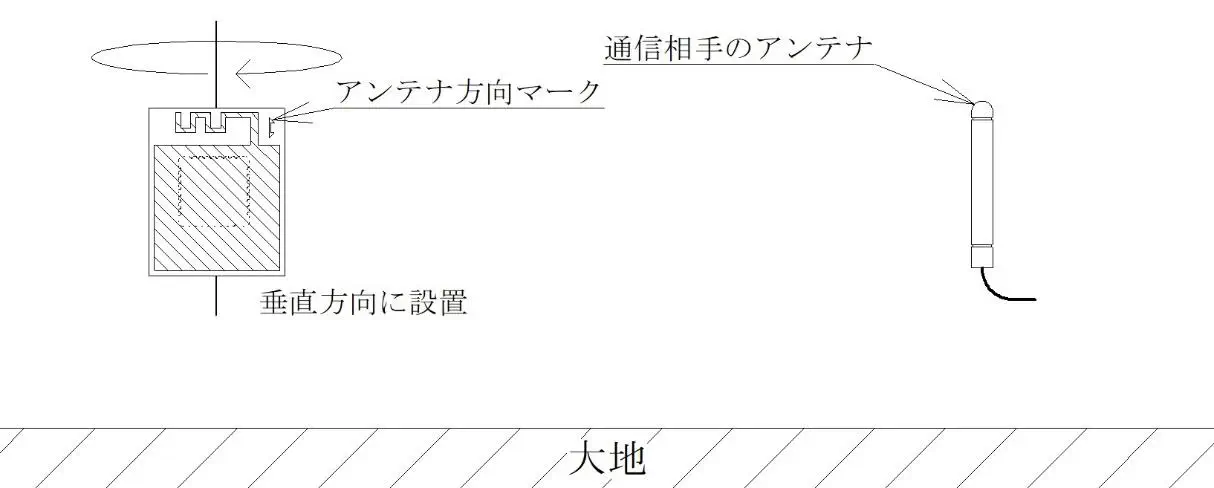
Standard Installation Method
- When installed horizontally, omnidirectionality cannot be obtained.
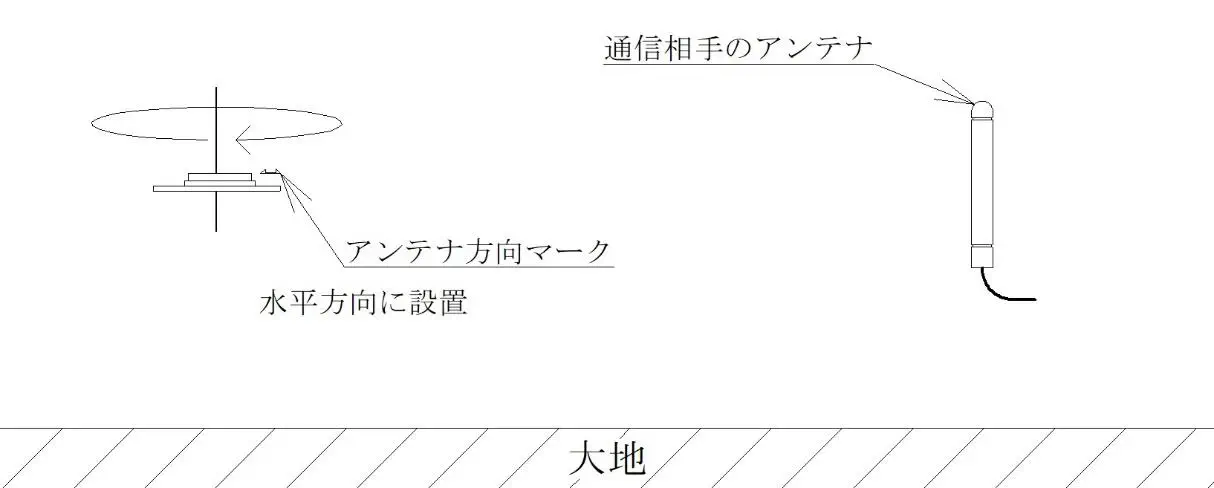
Non-standard Installation Method
Outline Drawing, Dimensions, and TWELITE Mounting Diagram
- Hatched area: copper foil formed on the printed circuit board.
- PCB substrate material: FR-4 (unchangeable)
- PCB substrate thickness: 0.5 [mm], 0.8 [mm], 1 [mm], 1.6 [mm] There are restrictions on the antenna pattern, PCB substrate thickness, and substrate material for radio certification. For details, refer to the section “About Radio Certification”.
- The antenna pattern is optimized for a PCB substrate thickness of 1 [mm], so characteristics slightly change if the substrate thickness differs. However, these changes are usually minimal. Characteristic patterns on a board based on an ideal GND size show changes of about 1–3 [dB].
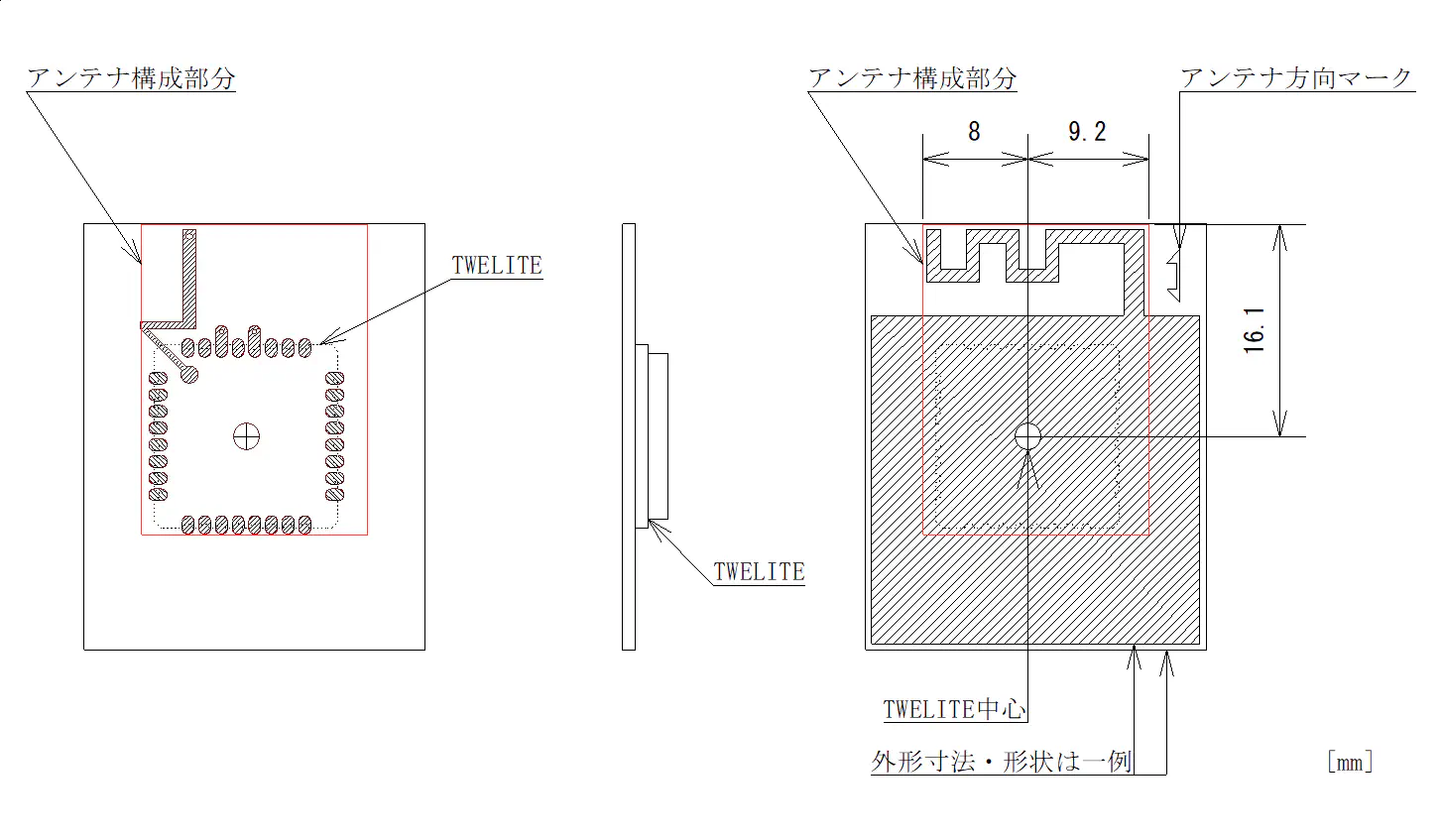
Outline Drawing and Dimensions
Specifications
| Model Number | MW-A-P1934 |
|---|---|
| Gain | Nominal 2.8 [dBi] <Note 1> |
Note 1: This is the radio certification application value based on measurements in all directions and may differ from the maximum value in the directivity chart below.
Directivity
Directivity Measurement Method 1 (Standard Installation Method)
- Measure the vertical plane
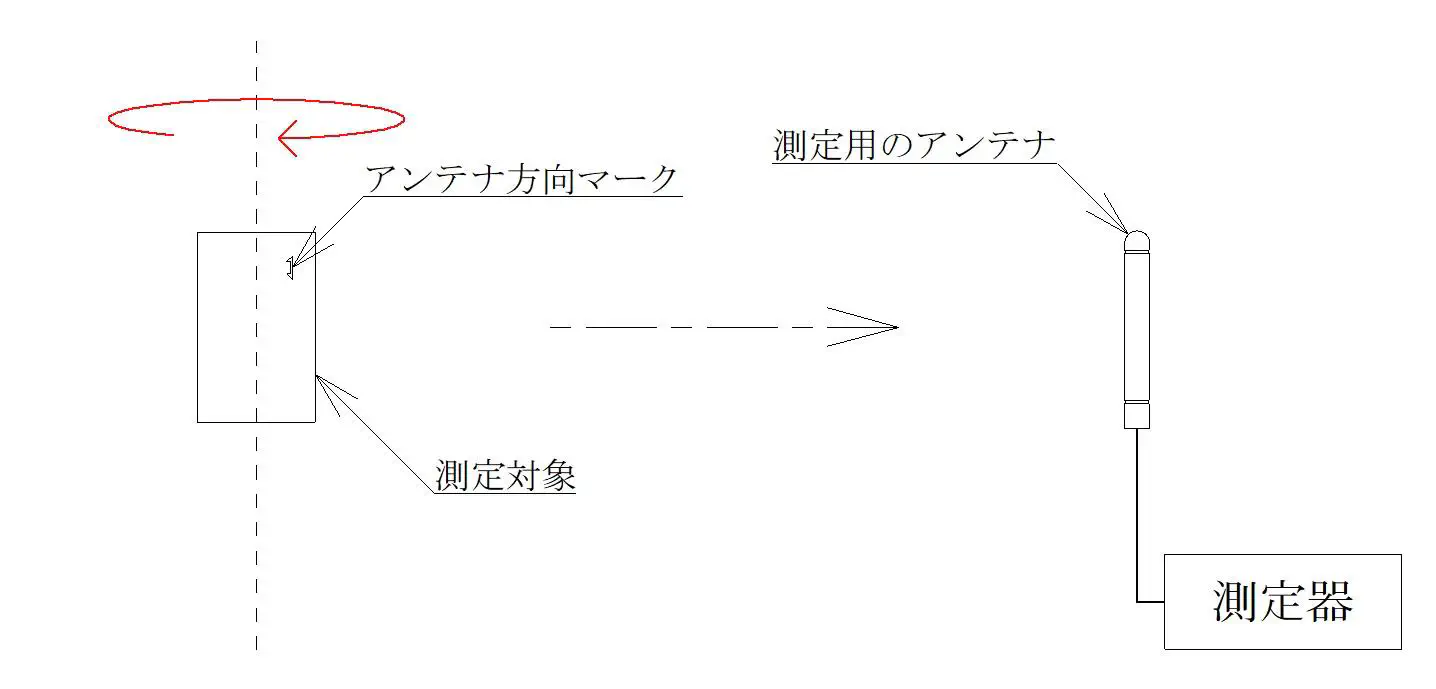
Vertical Plane Measurement
- Vertical plane directivity
| Maximum | Minimum | Average |
|---|---|---|
| -1.92 [dB] | -3.27 [dB] | -2.52 [dB] |
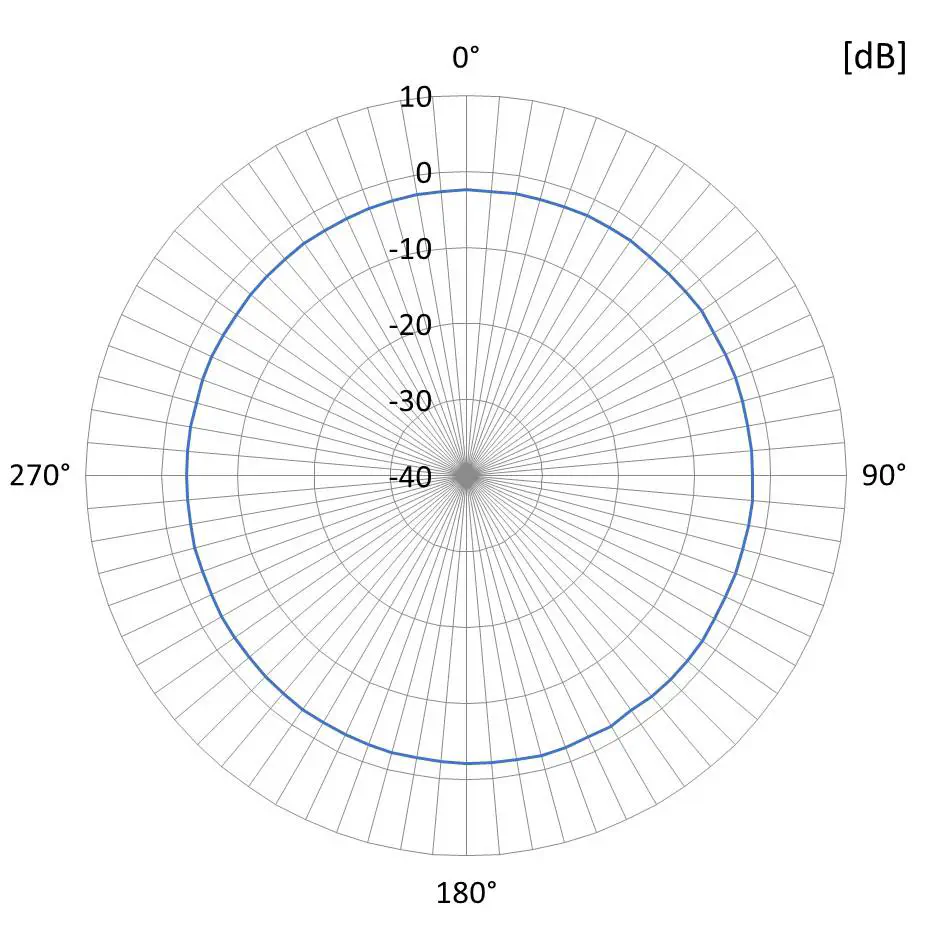
Vertical Plane Directivity
- Rotation direction of the measurement target and measurement angle
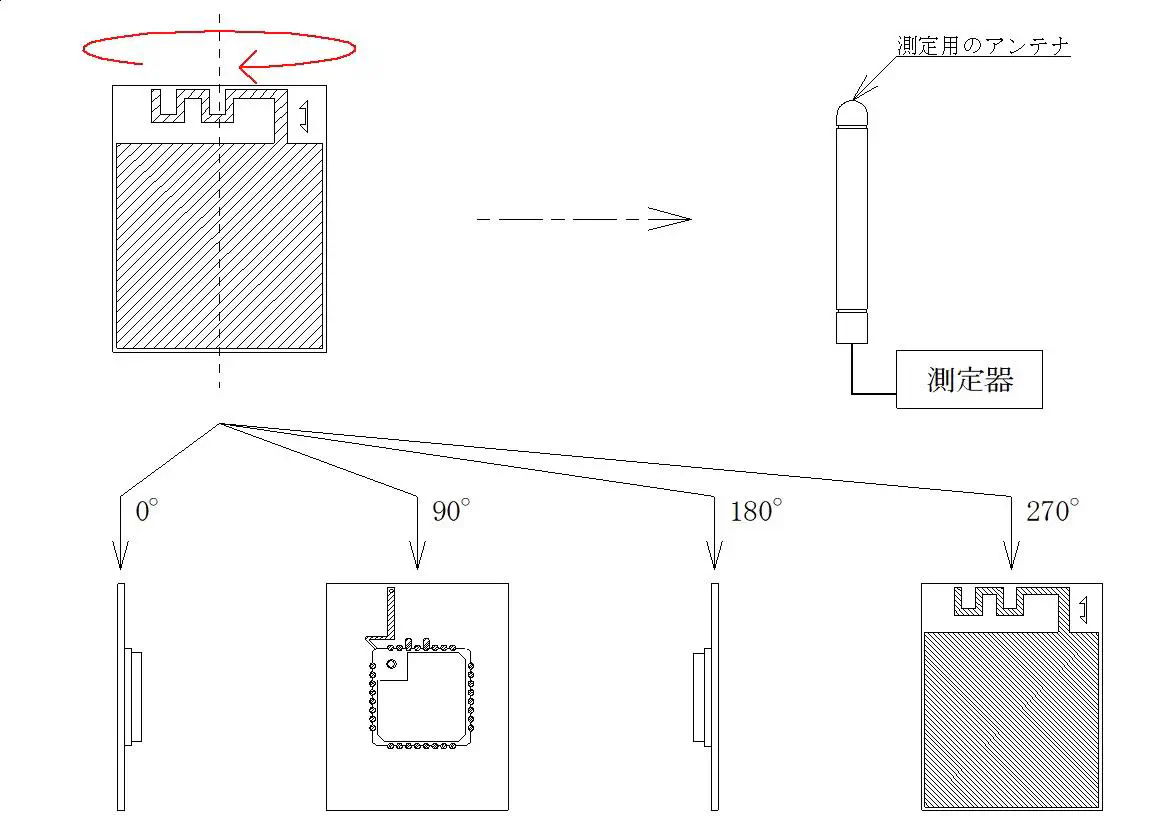
Rotation Direction of Measurement Target and Measurement Angle
Directivity Measurement Method 2
- Measure the horizontal plane
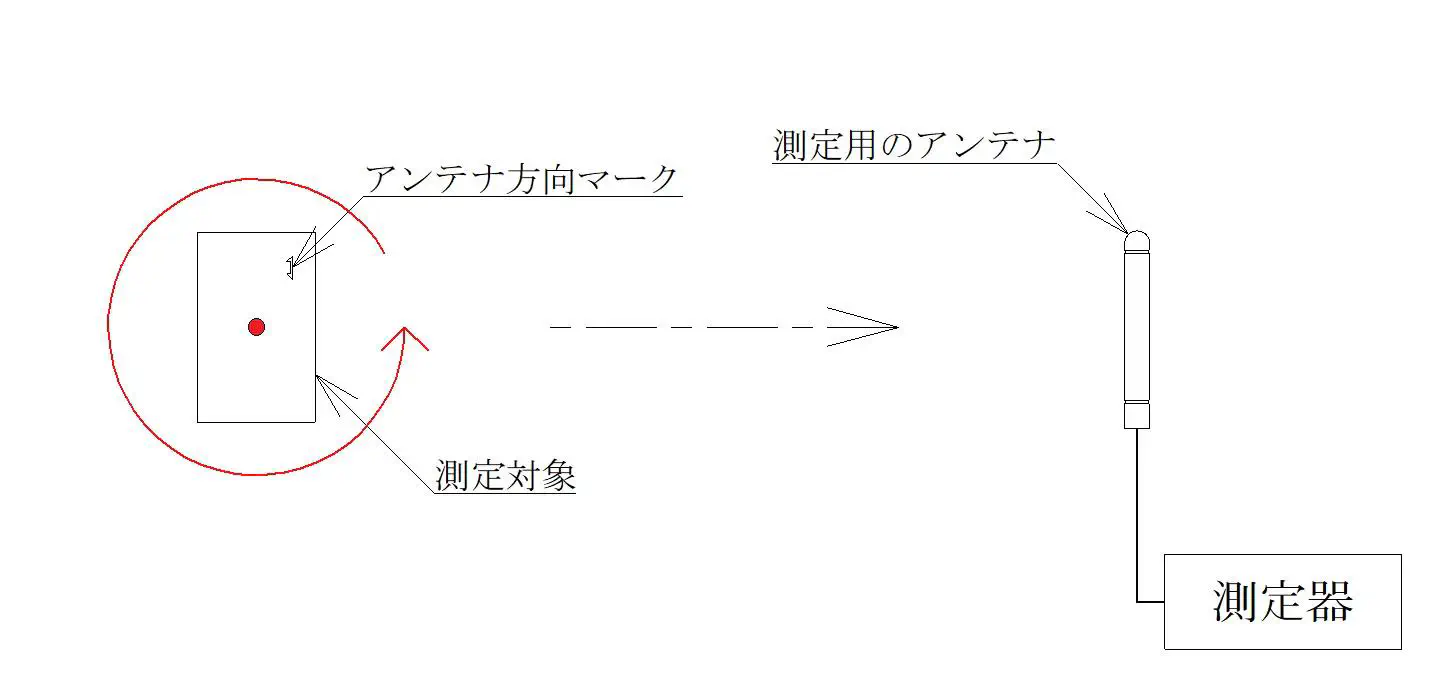
Horizontal Plane Measurement
- Horizontal plane directivity
| Maximum | Minimum | Average |
|---|---|---|
| -1.8 [dB] | -11.64 [dBi] | -4.88 [dBi] |
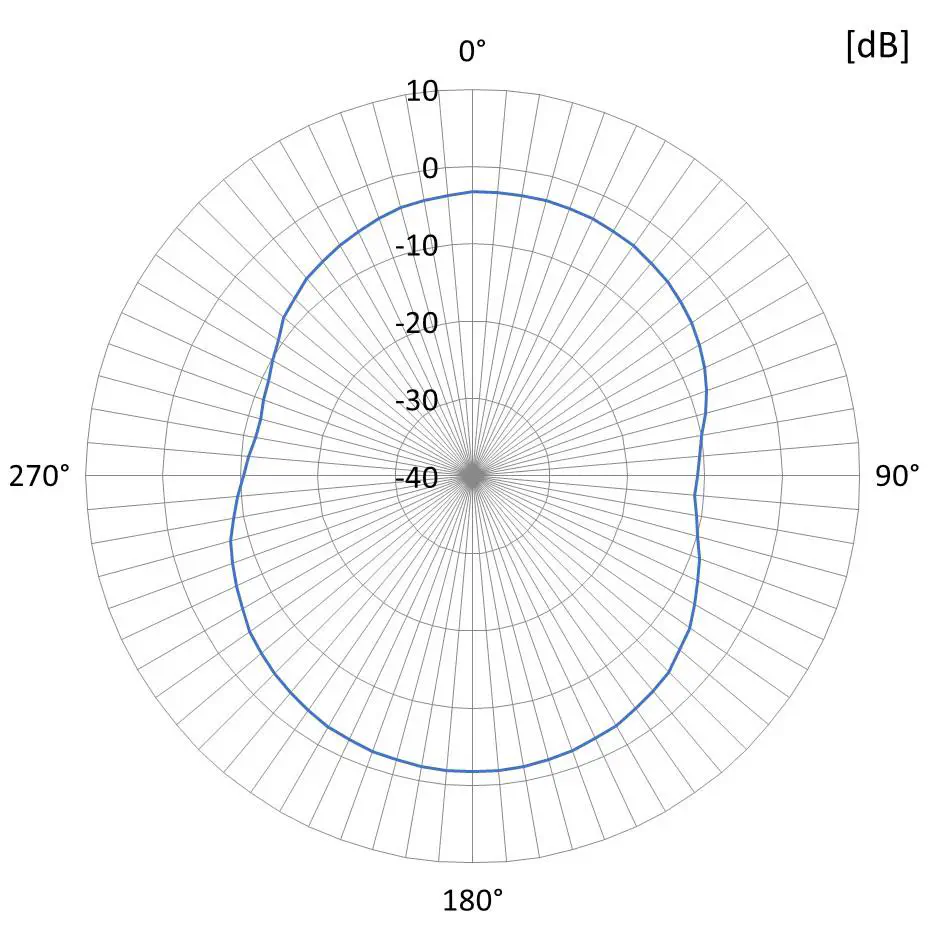
Horizontal Plane Directivity
- Rotation direction of the measurement target and measurement angle
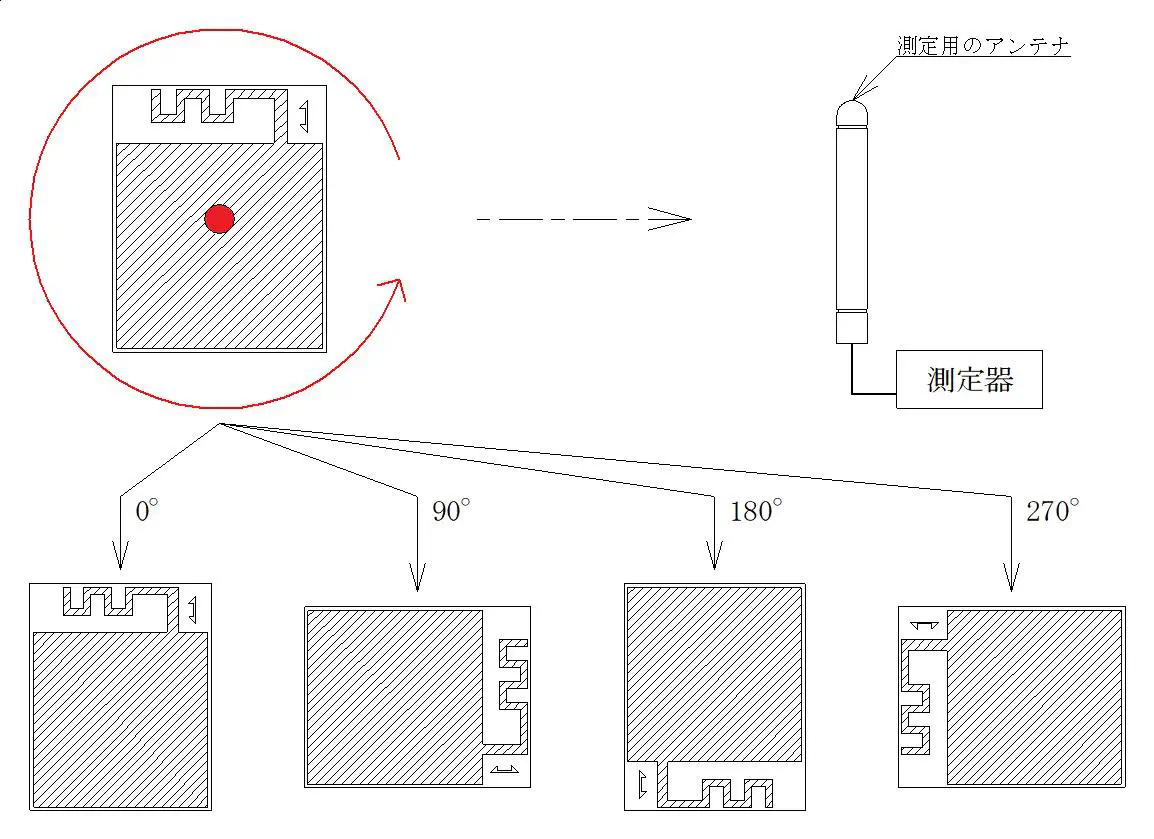
Rotation Direction of Measurement Target and Measurement Angle
Note: 0 [dB] on the directivity chart corresponds to the gain of a standard dipole antenna. Note: TWELITE was mounted on a printed circuit board measuring 32.75 [mm] × 26.00 [mm] with a substrate thickness of 1 [mm], and gain and directivity were measured.
About Radio Certification
There are restrictions on the antenna pattern, PCB substrate material, and substrate thickness for radio certification.
In Japan, radio certification applications are made under the following conditions:
- Antenna pattern: design as shown in <Figure: Outline Drawing and Dimensions>
- PCB substrate material: FR-4
- PCB substrate thickness: 0.5 [mm], 0.8 [mm], 1.0 [mm], 1.6 [mm]
- Target modules: TWE-L-WX, MW-R-WX, MW-G-W
Outside Japan (FCC, CE), radio certification applications are made under the following conditions:
- Antenna pattern: design as shown in <Figure: Outline Drawing and Dimensions>
- PCB substrate material: FR-4
- PCB substrate thickness: 1 [mm]
- Target module: TWE-L-WX
For details, please refer to the URL below.
https://twelite.gitbook.io/general/radio-cert/design-revf-ant
2 - Matchstick Antenna
2.1 - Matchstick Antenna Data Sheet
Product Overview
A matchstick antenna dedicated to the TWELITE series.
Main Features
- Antenna dedicated to TWELITE Twilight and wire antenna types. (Cannot be connected to coaxial connector types.)
- Can also be used bent. (When standing upright, it has characteristics closer to a dipole.)
- Environmental consideration: RoHS compliant
Standard Installation Method
- To obtain similar radiation characteristics (omnidirectional) in all directions, install the matchstick antenna vertically as shown in the figure.
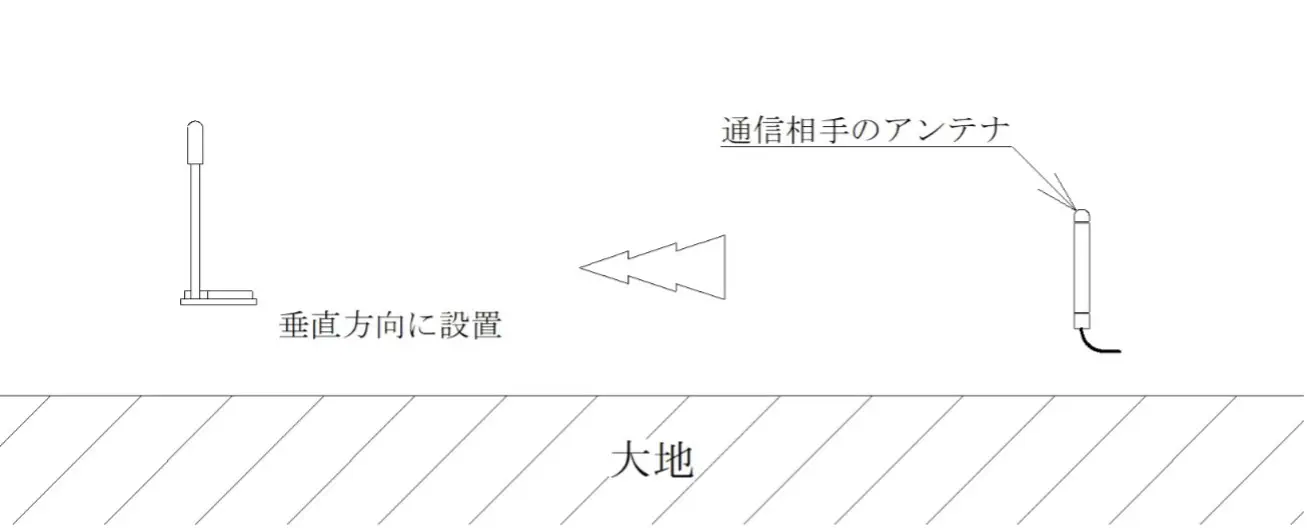
- When the matchstick antenna is installed horizontally, omnidirectionality cannot be obtained.
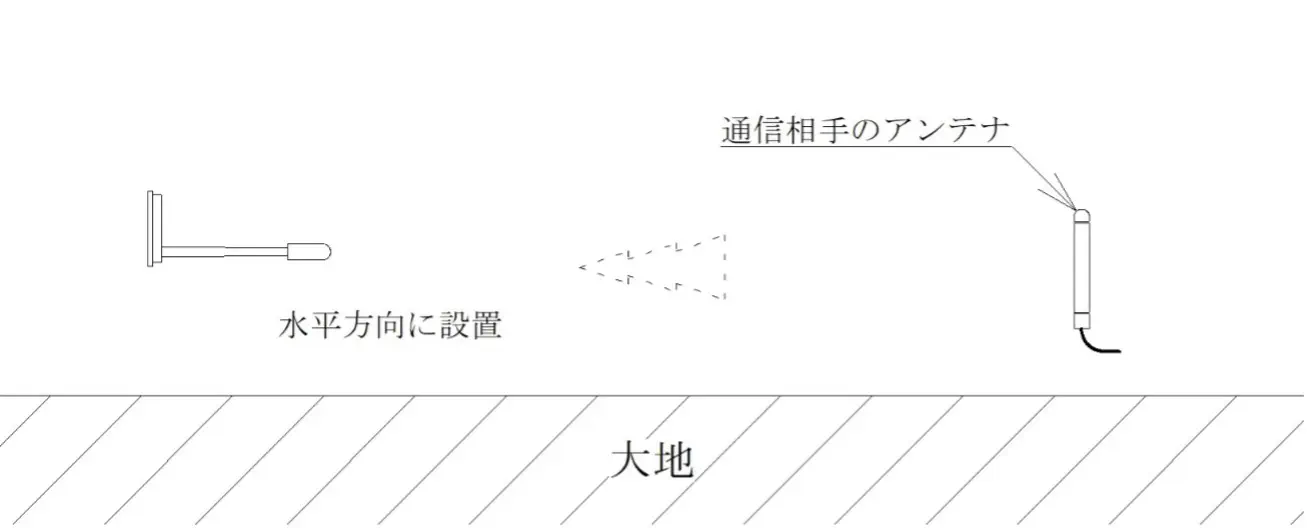
External Dimensions
- Outline drawing and dimensions
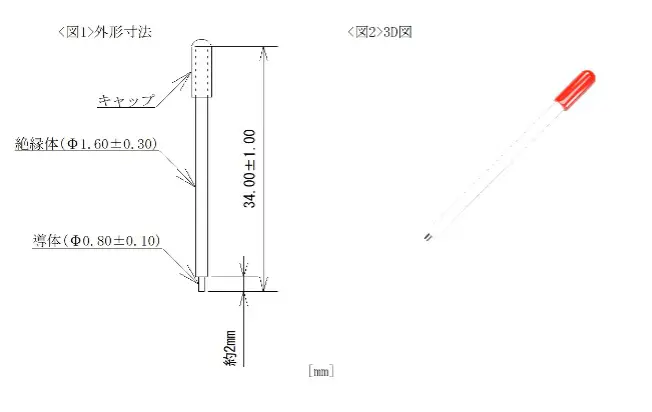
- MW-A-W0 Mounting diagram
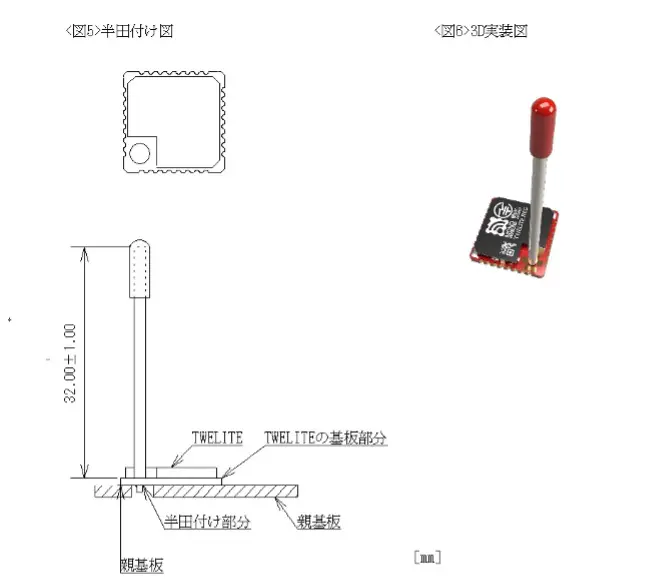
Mounting Example
- The shape, design, and board thickness of the printed circuit board in <Figures 7~8> are examples and can be changed according to the application. To ensure antenna performance, wiring and electronic components (sensors, switches, etc.) are usually placed on the TWELITE mounting side, and the opposite side has a solid GND and battery holder.
- <Figures 7~8> are transparent views.
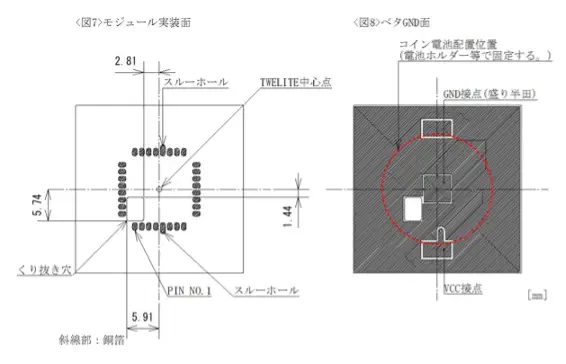
Mounting example of printed circuit board (FR-4 t=1.6)
Specifications
| Model Number | MW-A-W0 |
|---|---|
| Gain | Nominal 2.0 [dBi] <Note 1> |
| Operating Temperature Range | Wire: -40 |
| Connection Method | Insert into the wire antenna terminal and solder for use. |
Note 1: This is the radio certification application value based on measurements in all directions and may differ from the maximum value in the directivity chart below.
Directivity
- Directivity Measurement Method 1 (Standard Installation Method)
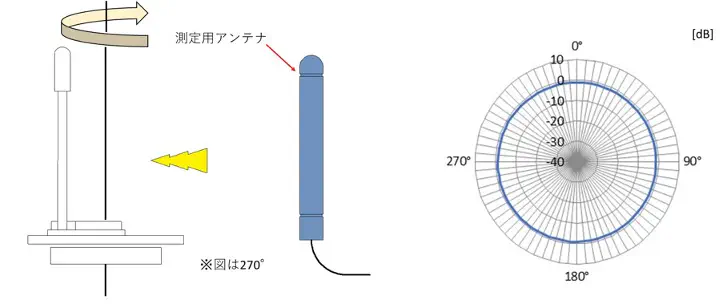
Maximum: -0.8[dB] Minimum: -1.4[dB] Average: -1.2[dB]
- Directivity Measurement Method 2

Maximum: -0.6[dB] Minimum: -17.4[dB] Average: -3.8[dB]
Note 3: 0[dB] in the directivity chart corresponds to the gain of a standard dipole antenna.
Note 4: TWELITE was mounted on the printed circuit board in <Figures 7~8> (solid GND size 30[mm]×30[mm]) to measure gain and directivity.
Remarks
- Gain and directivity vary depending on the solid GND size of the printed circuit board on which TWELITE is mounted, external wiring, batteries, and placement of electronic components (sensors, switches).
- If metal parts or wiring are placed around the MW-A-W0, antenna characteristics may be significantly affected. Examples with relatively small impact include resin, printed circuit boards without wiring (thickness: about 1~1.6[mm], material: FR-4, etc.), and resin screws.
- When using inside a case, a case thickness of about 1.5~2[mm] and materials such as ABS resin or polycarbonate are recommended.
- It is recommended that the solid GND size of the printed circuit board on which TWELITE is mounted be about 20[mm]×20[mm] to 40[mm]×40[mm].
2.2 - Matchstick Antenna Data Sheet
Product Overview
A matchstick antenna dedicated to the TWELITE series.
Main Features
- Antenna dedicated to TWELITE Twilight and wire antenna types. (Cannot be connected to coaxial connector types.)
- Can also be used bent. (When standing upright, it exhibits characteristics closer to a dipole.)
- Environmental consideration: RoHS compliant.
Standard Installation Method
- To obtain similar radiation characteristics (omnidirectional) in all directions, install the matchstick antenna vertically as shown in the figure.

- When the matchstick antenna is installed horizontally, omnidirectionality cannot be obtained.

External Dimensions
- Outline drawing and dimensions
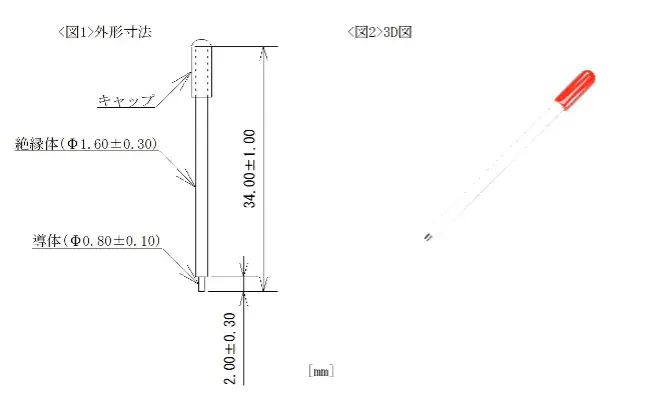
- MW-A-W0 mounting diagram
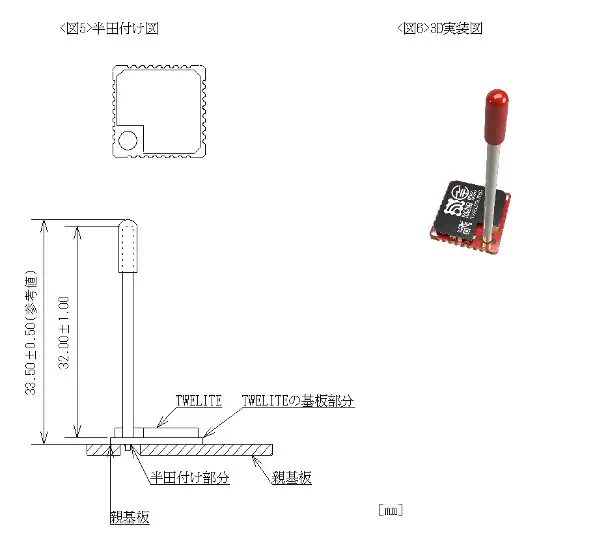
Mounting Example
- The shape, design, and board thickness of the printed circuit board in <Figures 7~8> are examples and can be changed according to the application. To ensure antenna performance, wiring and electronic components (sensors, switches, etc.) are usually placed on the TWELITE mounting side, and a solid GND and battery holder are placed on the opposite side.
- <Figures 7~8> are perspective views.

Mounting example of printed circuit board (FR-4 t=1.6)
Specifications
| Model Number | MW-A-W0 |
|---|---|
| Gain | Nominal 2.0 [dBi] <Note 1> |
| Operating Temperature Range | Wire: -40 |
| Connection Method | Insert into wire antenna terminal and solder for use. |
Note 1: The value for radio certification application is based on measurements in all directions and may differ from the maximum value in the directivity chart below.
Directivity
- Directivity Measurement Method 1 (Standard installation method)

Maximum: -0.8[dB] Minimum: -1.4[dB] Average: -1.2[dB]
- Directivity Measurement Method 2

Maximum: -0.6[dB] Minimum: -17.4[dB] Average: -3.8[dB]
Note 3: 0[dB] on the directivity chart corresponds to the gain of a standard dipole antenna.
Note 4: TWELITE mounted on the printed circuit board in <Figures 7~8> (solid GND size 30[mm]×30[mm]) for gain and directivity measurement.
Remarks
- Gain and directivity vary depending on the solid GND size of the printed circuit board on which TWELITE is mounted, external wiring, battery, and placement of electronic components (sensors, switches).
- If metal parts or wiring are placed around the MW-A-W0, antenna characteristics may be significantly affected. Examples with relatively small influence include resin, printed circuit boards without wiring (thickness: about 1~1.6[mm], material: FR-4, etc.), and resin screws.
- When used in a case, a case thickness of about 1.5~2[mm] and materials such as ABS resin or polycarbonate are recommended.
- It is recommended that the solid GND size of the printed circuit board on which TWELITE is mounted be about 20[mm]×20[mm] to 40[mm]×40[mm].